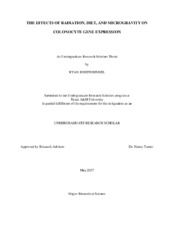| dc.description.abstract | Recent progress has been made in understanding the physiological responses to conditions prevalent in the space flight environment, including radiation source, duration of radiation exposure, weightlessness, and diet. The aim of this project was to use an experimental model simulating the space environment to investigate the immune response with exposure to oxidative stress, weightlessness, and continuous low dose ionizing radiation. Mice were randomly assigned to groups according to a 2 x 2 x 2 factorial design of continuous cobalt (60Co) radiation (C-RAD) or no radiation (SHAM), weight bearing or hind limb unloaded, and a diet with high or normal iron levels. The mice (n=50) were given a 45 or 650 mg iron/kg diet, and maintained in a full body head down tilt for 42 days during the radiation treatment phase. Continuous radiation (C-RAD) mice were exposed to a whole-body dose of 60Co gamma (γ) radiation on a continuous basis (0.5 mGy/hour) over the 6-week HU period, resulting in a total dose of 0.5 Gy. A malfunction in the RT-PCR machine during our first set of analyses resulted in no data being acquired. Unfortunately, this caused a decrease in the number of samples available for subsequent analysis. The decrease in available samples resulted in it only being feasible to make comparisons using a 2 x 2 factorial design of dietary iron level and hind limb unloaded state. The remaining treatment groups received the normal dietary iron and were cage controls (CC, n=3), or hind limb unloaded (HU, n=4), or they received the high iron diet (CC + Fe, n=4; HU + Fe, n=4). Gene targets of interest (TNF-, and Slc5a8) were analyzed and the data normalized using 18S RNA. There were no significant changes in expression of TNF- and Slc5a8 caused by the elevated iron diet or hind limb unloading or their interaction. Even though there were no significant differences, there is a demonstrated tendency for increased expression of TNF- and Slc5a8 in all treatment groups, relative to the cage controls receiving the normal iron diet. These observations suggest the potential for these variables to have an impact on intestinal and systemic health of astronauts. More experiments with greater numbers of observations are necessary to explore the effects of radiation, diet, and weightlessness. | en |


